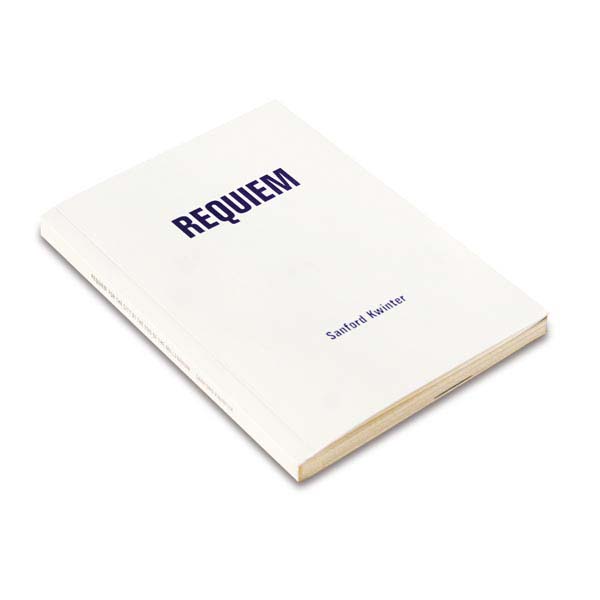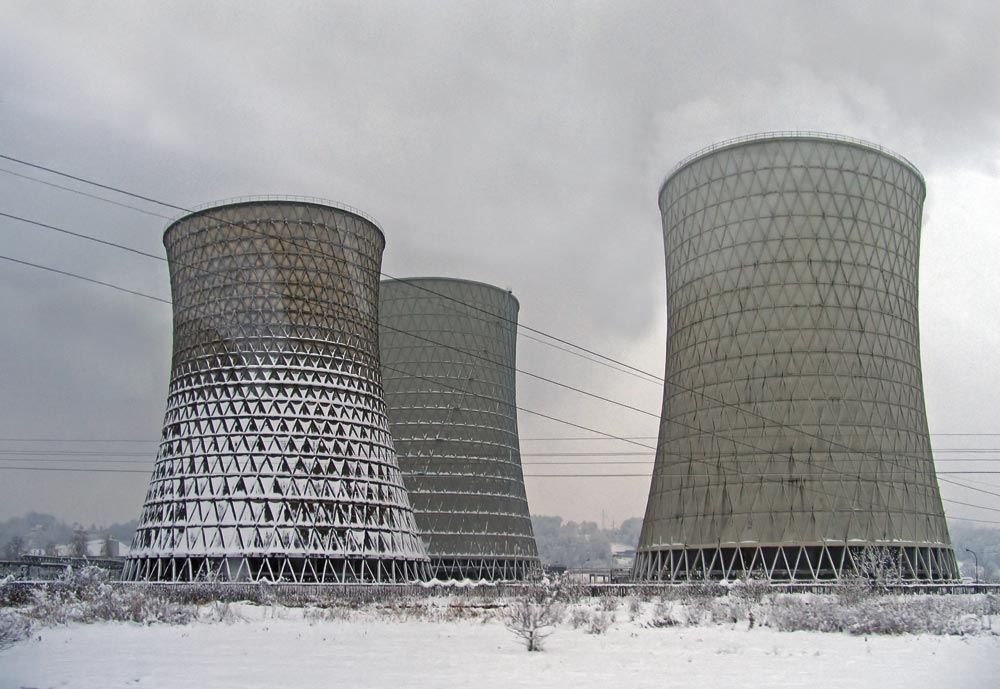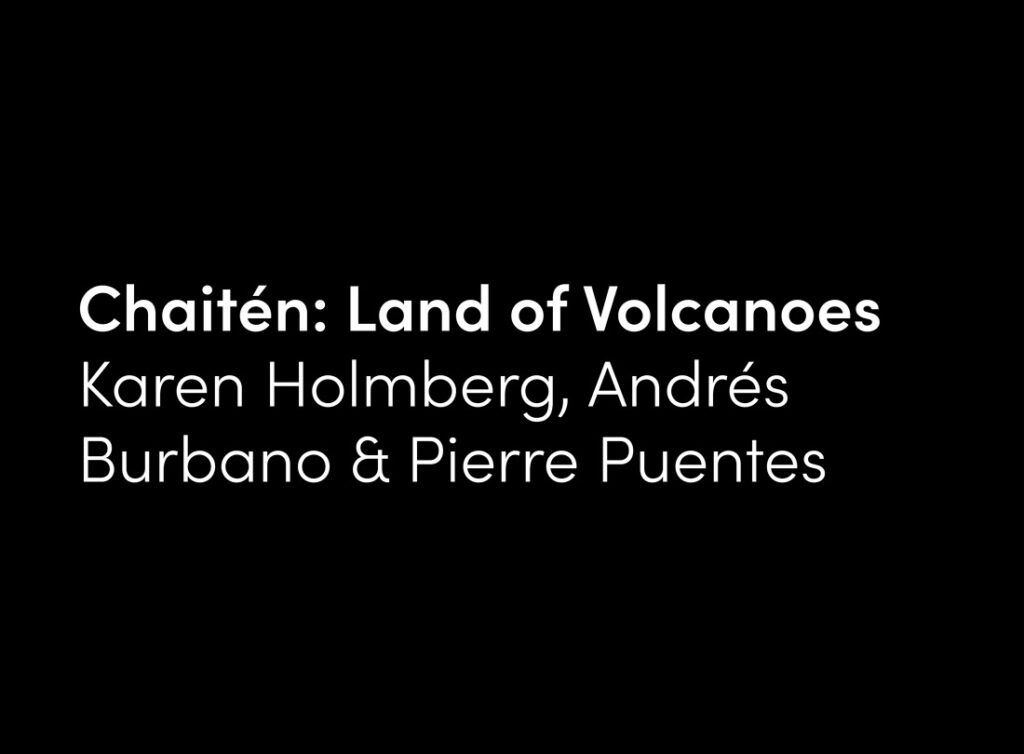The poverty of much urbanist thought can be traced to a persistent fallacy: that the city, or Metropolis, expresses itself preeminently in its physical form and that it is amenable to analysis and intervention as a finite concrete object alone. The city, however, is not this but rather a perpetually organizing field of forces in movement, each city a specific and unique combination of historical modalities in dynamic composition.
Thermoelectric Power Plant Cooling Towers, Tuzla, Bosnia and Herzegovina, David Kitching (2008)
The transformations affecting cities in the postwar era have been extraordinary—even unprecedented—but as a rule have yielded more readily to literary, photographic, and especially cinematic documentation than to traditional scientific (quantitative) analysis. To grasp the underlying shaping processes, to make them available to perception or intuition, seems to require a more oblique approach, one that recognizes the wildness of the compositional forces that subtend the city’s existing forms, activities, and practices. Cities are always epiphenomenal: they are the expressions of broader and more remote developments and sets of forces, specifically economic and social ones.
Indeed, the organization of a given economy and society—as mutually engendering domains—is what first invented and now drives and shapes the concrete constellations that we call cities. This organization may be thought of as the DNA of the city, its scaffold, its ultimate infrastructure. Perhaps more than anything else, these infrastructures constitute the historical element of cities and are their preeminent engines of change.
But how exactly are we to understand infrastructure, this new, now largely invisible compositional reality? By “infrastructure” one means every aspect of the technology of rational administration that routinizes life, action, and property within larger (ultimately global) organizations. Today it can be argued that infrastructures own a little part of every thing. Infrastructure includes the systemic expression of capital, of deregulated currency, interest rates, credit instruments, trade treaties, market forces, and the institutions that enforce them; it includes water, fuel, and electrical reservoirs, routes, and rates of supply; it encompasses demographic mutations and migrations, satellite networks and lotteries, logistics and supply coefficients, traffic computers, airports and distribution hubs, cadastral techniques, juridical routines, telephone systems, business district self-regulation mechanisms, evacuation and disaster mobilization protocols, prisons, and subways and freeways with their articulated connections; it includes libraries and weather-monitoring apparatuses, trash removal and recycling networks, sports stadiums and the managerial and delivery facilities for the data they generate, parking garages, gas pipelines and meters, hotels, public toilets, postal and park utilities and management, school systems and ATM machines; it covers celebrity, advertising and identity engineering, rail nodes and networks, television programming, interstate systems, entry ports and the public goods and agencies associated with them (Immigration and Naturalization Service, National Security Agency, Internal Revenue Service, Food and Drug Administration, Bureau of Alcohol Tobacco and Firearms); it comprises sewers and alarms, the multitiered military-entertainment apparatus, decision engineering pools, wetlands and water basins, civil structure maintenance schedules, epidemiological algorithms, cable delivery systems, police enforcement matrixes, licensing bylaws, greenmarkets, medical-pharmaceutical complexes, internet scaffolds, handgun regulations, granaries and water towers, military deployment procedures, and street and highway illumination schemas; in short, infrastructure concerns regimens of technical calculation of any and all kinds.
The modern city until the Second World War was both founded within, and a direct expression of, modern bureaucratic structure. This “modernist” city was governed by rational, even Newtonian principles of organization and procedure. Spontaneous and serendipitous action was largely reduced by standardized rules of administration, conduct, and law. Social space was compartmentalized according to the principles of division of labor and the further refinements of vocational specialization, while social action was carried out according the rule of the office (both the literal “bureau” and the office as an abstract “charge” or task). And everything was subject to democratic procedure and the principle of centralized administration that subtended it. Most importantly, this entire system was based on the concept of “files,” that is, official records in the form of written documents whose meanings, principles of organization, and rules of handling and manipulation were subject to administrative regulation and protocol. Social and economic life was, at least in principle, subject to rational and universal rules. The way this modern society was organized and the way its knowledge was stored and deployed had in fact become indivisible and identical processes.
It is precisely these underlying organizational and epistemological principles that are undergoing transformation today. In the last four decades, the great age of the modern bureaucracy and large-scale nongovernmental and corporate organizations (from the late nineteenth to the mid-twentieth centuries) has begun to confront new rationalizing forces. The disrupting effect of these forces on what had seemed to early twentieth-century sociologists to be an irreversible and one-way historical process was at first gradual yet now appears decisive. These new forces were (1) automatic electronic data processing, (2) the rise of a vast, densely knit global image culture, (3) the democratization of access to the public sphere and the demise of “mass” culture, and (4) the rise of the “market model” of social organization.
First, the advent of electronic data processing, whose most dramatic exemplar is the internet, meant that the collective knowledge bank would no longer be fed through routinized “office” channels, but through entirely random and unregulated ones. This produced an n-fold multiplication of circulating data and a diminishment of the prestige of quality sources. The result has been a newly tolerated indeterminacy with regard to the quality of knowledge and a surprising acceptance of the egregious instability of the automatic system that delivers it. In addition to this, the “intelligence” that is now embedded in the organizational system itself is unprecedented in the history of bureaucracy. Because the electronic data infrastructure is also a vehicle of social, public, and official transactions and because it is so deeply endowed with automatic process, it produces knowledge and history, or rather it allows knowledge and history to be produced instantaneously and without the familiar mediating “pathos of distance.” And because the knowledge or history is electronic, once produced, it is subject to a life cycle entirely different from that of paper records and files. Some knowledge (such as government records of email exchanges and interdepartmental memorandums) can be dumped—instantly and irrecoverably lost—while other utterly trivial data sets float forever in the infinity of cyberspace simply because they are no longer subject to the Darwinian pressures of finite resources, competition, and survival. There can be no doubt that the fundamental shape and quality of the collective social and historical “archive” is being profoundly transformed as a result. [1]
The rise of the hegemony of the image and its gradual supplanting of alphabetically organized documents has left another important mark on the historical “archive” and so on the nature of recorded knowledge. The twentieth century is perhaps the first in a millennium to have left a more substantial record of itself in images than in ledgers and texts. Images, thanks (at the very least) to surveillance video equipment and web cams, are now being produced automatically and indiscriminately at an increasing rate, a state of affairs that could never hold with text. Text, of course, can be retrieved more easily by means of keyword searches than images, but time coding, inexpensive storage infrastructure, and digitization are making images increasingly editable, exchangeable, and recyclable. The web “revolution” Napster (1999) allowed users to exchange data files and automatically administrate their disposition without the mediation of a centralized server. Though this phenomenon primarily concerned music files, there is no reason why such a system would not be applicable to other streaming data such as film and video (and later to the communication of actual sensation). [2] In today’s electronic agora, the truth-function—the minimal assembly criteria necessary for an artifact to be held and circulate as a “fact”—is increasingly limited to context-specific applications and to the low definition standards of what is “shown” (photographically) rather than what is “demonstrated” (numerically) or “said” (alphabetically and dialectically).
This new order of social knowledge triumphs precisely where the old one is being systematically eroded and transformed by the so-called “democratization” of tools, communications, and access to public address. The main transformation concerns the destruction of the artificial structures of collective experience and culture, and the blocking of the formation of the “mass” subjectivity and “historical sense” traditionally fostered by centrally organized and shared artifacts that are embedded within processes, which are themselves embedded within experience. Serendipity, miscellany, and the diminished authoritarian unity of social existence are the new orders of the day, and these mixed values are rapidly dismantling the familiar consensual structures of what once constituted an epoch, an age, or even an “event.” Today, relativism is being incorporated even into our juridical, administrative, and political apparatuses.
The term “disintermediation” ranks among the most significant catchwords of our day. It describes the set of processes through which “embedded communication” (i.e., internet) technologies and protocols have begun to promote the elimination of the rich “middle” culture in social and economic transactions—in other words, the removal of all intermediaries, brokers, agents, consolidators, clerks, and salespeople, anyone or any institution that adds either value, cost, or dimension to a transaction. Disintermediation, however, does not simply produce a gain in “efficiency”; it changes the very channels and pathways through which capitalism operates (consider the transformation in distribution networks alone [3]). Nor do these ostensibly economic innovations come without their social costs: their tendency is to eliminate a vast portion of the entire urban matrix that once subtended these activities—the sidewalks, shopkeepers, cafés, taxis, communion with fellow shoppers—and especially the multiple relations that knit these elements together. In American neo-liberal society, for example, the ethos of disintermediation (through democratization of communications infrastructure) is now penetrating into every aspect of social consciousness and ritualized behavior. [4]
Finally the neo-liberal market model itself is rapidly supplanting the old, rigorously defined bureaucratic structures of administration that originally made democracies possible. It might even be said that the first three developments—information automation, ascendancy of images, democratization of publication—rely entirely on this one: that the final transformation of society by markets was dependent on the advent of the technological infrastructures represented by the first three. At any rate, the belief in unregulated markets has become almost a religion in contemporary society. People no longer believe that knowledge and truth should determine the directions, behaviors, and uses of markets but the opposite: markets now decide what is good, useful, and true, so long as all elements are free to fluctuate (that is, remain indeterminate and unstable) for continuous redeployment. Our societies are increasingly market societies, and our social and personal lives are increasingly exposed to the law of self-organization, information science, and market efficiency. Advances in scientific epistemology and applied technology such as cybernetics, complexity theory, and thermodynamics are routinely called on to legitimate the new system as a direct expression of Natural Law. The public institutions and practices whose role was once to invent mechanisms through which markets could be put at the service of ideas, desires, and ambitions formulated in a sphere free of market logic are now commonly demonized as agents of (external and intrusive) “regulation.” The wave of laissez-faire enthusiasm that is sweeping us along, like each one that preceded it, will eventually come to an end, but the social and ethical transformations—based on real, albeit cold efficiencies—that this market primacy will have lodged in place are to a large degree irreversible. No analysis of our contemporary cultural situation can fail to take this factor into consideration. Our civilization and all its structures—our cities preeminent among them—are endowed now with a largely new genetic inheritance for future generations to confront.
Transmission Masts, Nacka, Stockholm, Bengt Rehnström (2009)
How, then, does one produce a systematic reflection on the transformations that contemporary cities are undergoing? It is arguable that never before in history has the relation of a social object to the data sets that represent it been so intimately linked as now. Thanks to the explosion of “tele-compunications,” the City today, to a greater degree than ever before, actually is those data sets and is those networks of public equipment through which data circulates. Our rapidly disarticulating city is increasingly reconstituting itself, in vitro as it were, as a dynamic archive, where “archive” is understood as the massive depository of local and global knowledges that (in the manner of any natural ecology) provide a maximally flexible, “satisficing” (“suffice” + “satisfy”) infrastructure for life. [5] An exhaustive inventory of the City, which is futile in principle anyway, could only in the end mislead. The more interesting task is to identify the forces and directions and regimes that are currently shaping developments, not the sedimented and confusing substrate upon which these historical forces play. [6]
Capturing the dynamic picture requires two attitudes. The first is to accept the idea that just as a photograph is said to capture an “action,” so the task of sending a probe through the contemporary urban archive will yield a snapshot of something mobile yet true (if invisible to the organic embedded eye). This could be called the “bioptic” approach: the removal of a few cells from an organism through which to deduce a far broader set of understandings of the entire organism. The second is to accept the non-exhaustive nature of both the method and of any result (with attendent distortions, as in the parable of the three sightless men inspecting an elephant, each projecting a different animal from the limited data at hand). This involves acceptance of the corrupt and fugitive nature of the archive itself (the internet, our collective system of memory today, more resembles a sewer system into which nondegradable artifacts are indiscriminately thrown than an engineered “superhighway” on which licensed vehicles and rational, consensus-based trajectories are played out) and an act of faith. We must believe that the very speed and arbitrariness of the project—as performatively conceived—delivers something virtuous in ways that more refined and disciplined eras and methods could not: it places scientific method and political action in the hands of everyone with a phone line and a hard drive. Urbanism is simply no longer a specialist’s task. [7]














